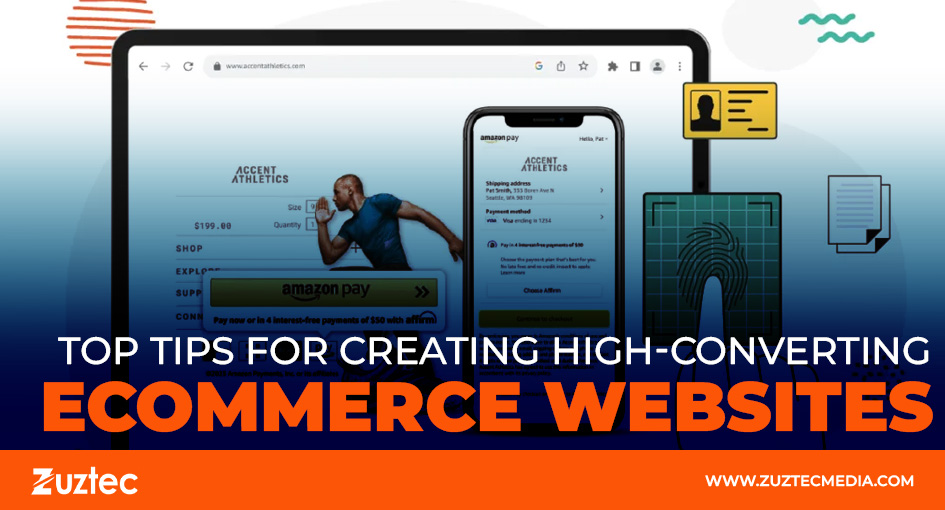
Top Tips For Creating High-Converting Ecommerce Websites
The digital marketplace is expanding rapidly, and businesses of all sizes are turning to ecommerce to reach more customers and boost their sales. Whether you’re a startup selling handmade goods or a large retailer expanding your digital footprint, a well-designed ecommerce websites can be the key to long-term growth and customer satisfaction.
The functionality and design of e-commerce websites directly influence user experience, conversion rates, and even search engine rankings. With online competition at an all-time high, simply having a website isn’t enough—you need one that is fast, responsive, and tailored to your target audience’s needs.
In today’s fast-paced environment, users expect a seamless browsing and shopping experience. That includes everything from easy navigation and mobile compatibility to secure payment options and fast checkout processes. If your site falls short in any of these areas, potential customers will likely abandon their carts and take their business elsewhere.
Incorporating SEO best practices into your website’s structure, content, and metadata can significantly improve your visibility and attract organic traffic. This makes it crucial to balance aesthetics, performance, and marketing strategy when building or optimizing your site.
In this article, we’ll explore the fundamental elements that make e-commerce websites successful, how to choose the right platform, and best practices for boosting sales and customer satisfaction.
Why Ecommerce Websites Matter For Modern Businesses
E-commerce websites serve as the virtual storefronts for today’s businesses. With more consumers preferring online shopping over visiting physical stores, having a reliable ecommerce solution is essential for survival and growth. A well-developed ecommerce site allows for better inventory management, customer data collection, and personalized marketing efforts. By analyzing customer behavior through built-in analytics tools, businesses can refine their product offerings and improve customer engagement. These insights help tailor promotions, suggest relevant items, and foster customer loyalty.
As your business grows, adding new products or expanding into different regions can be done without the need for physical expansion. Automated tools can help manage shipping, customer communication, and inventory updates efficiently.
Security and trust are also key. A secure e-commerce platform with features like SSL encryption and trusted payment gateways helps build consumer confidence. Users are more likely to make purchases if they feel their personal information is safe.
Choosing The Right Platform For Your Ecommerce Needs
One of the most important decisions in launching an e-commerce store is selecting the right platform. There are many options on the market, each with its strengths and limitations.
It offers drag-and-drop design tools, various templates, and built-in payment solutions. For WordPress users, WooCommerce is a powerful plugin that integrates seamlessly with existing websites and provides a high level of customization.
Larger enterprises may opt for Magento, which offers advanced features and scalability but may require more technical expertise. BigCommerce is another robust option with good built-in SEO tools and multi-channel selling features.
Look at transaction fees, customization options, and integration with tools like CRMs, email marketing services, and accounting software. Good customer support and access to third-party developers are also valuable.
Design And Functionality Tips For Ecommerce Success
Design plays a significant role in the effectiveness of your ecommerce websites. A clean, modern interface that highlights your products makes browsing easier and improves the user experience. Use high-quality product images, clear descriptions, and concise calls to action to guide users toward a purchase.
Navigation should be intuitive. Categories and filters must be easy to locate so users can find what they’re looking for with minimal effort. A strong search function can also improve engagement, especially for stores with large inventories.
Mobile optimization is a must. A significant portion of online shopping is done via smartphones, so your site must be fully responsive. Slow-loading pages or awkward mobile interfaces can drive users away quickly.
Trust-building elements like customer reviews, return policies, and visible security badges reassure users during their purchasing journey. Additionally, streamlined checkout processes reduce cart abandonment. Offer multiple payment options, allow guest checkouts, and minimize the number of form fields.
Maintaining And Optimizing Your Ecommerce Site Over Time
Launching your ecommerce website is just the beginning. Continuous maintenance and optimization are crucial for long-term success. Regularly updating your product catalog, testing site speed, and fixing broken links help keep your website functional and appealing.
Search engine optimization (SEO) is an ongoing task. Use descriptive titles, optimized images, and relevant keywords throughout your content to improve visibility. Update metadata, add structured data, and create blog posts that target search queries relevant to your products or industry.
Email marketing remains a strong tool for ecommerce businesses. Send newsletters, discounts, or product updates to keep your audience engaged. Segment your email list for better targeting and include clear calls to action.
Final Thoughts On Building Successful E-commerce Websites
The success of ecommerce websites depends on strategic planning, great design, and constant improvement. Businesses that focus on user experience, functionality, and digital marketing are more likely to see long-term success. Whether you’re launching a new store or improving an existing one, make sure your platform, content, and customer service are working together seamlessly.
In conclusion, e-commerce websites are powerful tools that allow businesses to scale efficiently, reach a wider audience, and stay competitive in the digital age. By building a solid foundation and committing to ongoing optimization, your e-commerce site can become one of your most valuable assets.

